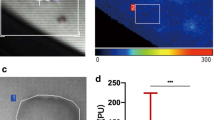Abstract
Background
There are many different keloid treatment modalities. One surgical technique is to keep the “shell” of the keloid to cover the defect. We named this “shell” keloid subepidermal vascular network flap (KSVNF), and we outlined the characteristics of this flap by observing 35 flaps in keloid patients.
Methods
A total of 35 KSVNFs were designed in 15 patients during 2020−2021. All patients underwent the operation and adjuvant radiotherapy as well as hyperbaric oxygen therapy. All flap lengths and widths were recorded, and the blood perfusion of the flaps was measured on the first day postoperation and the day of stitch removal. Flap survival and the quality of flaps were evaluated on the day of stitch removal. All harvested data were analyzed using the R (version 4.0.1) package.
Results
The mean blood perfusion on the first day postoperation (pod1) and the day of stitch removal was 120.4013 and 168.6900, respectively (p = 0.02249); 2 flaps had partial necrosis (5.714%). Receiver operating characteristic (ROC) curve analysis showed that when the length/width ratio was less than 1.05, the quality of the flap was good (AUC = 0.724), which suggests that the effective safe length/width ratio was 1.05.
Conclusion
KSVNF is an applicable method for covering the remaining wound after keloid mass removal with sufficient blood perfusion and adequate skin quality. We recommend that the length/width ratio of the flap design not exceed 1.
Level of Evidence IV
This journal requires that authors assign a level of evidence to each submission to which Evidence-Based Medicine rankings are applicable. This excludes Review Articles, Book Reviews, and manuscripts that concern Basic Science, Animal Studies, Cadaver Studies, and Experimental Studies. For a full description of these Evidence-Based Medicine ratings, please refer to the Table of Contents or the online Instructions to Authors www.springer.com/00266.











Similar content being viewed by others
Change history
19 April 2022
A Correction to this paper has been published: https://doi.org/10.1007/s00266-022-02889-5
References
GG Gauglitz HC Korting T Pavicic T Ruzicka MG Jeschke 2011 Hypertrophic scarring and keloids: pathomechanisms and current and emerging treatment strategies Mol Med. 17 1–2 113 25 https://doi.org/10.2119/molmed.2009.00153
R Ogawa S Akita S Akaishi N Aramaki-Hattori T Dohi T Hayashi (2019) Diagnosis and treatment of keloids and hypertrophic scars-japan scar workshop consensus document 2018. Burns Trauma 7:39 https://doi.org/10.1186/s41038-019-0175-y
YI Lee J Kim CE Yang JW Hong WJ Lee JH Lee 2019 Combined therapeutic strategies for keloid treatment Dermatol Surg. 45 6 802 10 https://doi.org/10.1097/DSS.0000000000001695
G Du J Zhu 2014 Ear keloid and clinical research progress Lin Chung Er Bi Yan Hou Tou **g Wai Ke Za Zhi 29 8 770 772 Epub 2014/04/01 PubMed PMID: 26248462
TA Mustoe RD Cooter MH Gold FD Hobbs AA Ramelet PG Shakespeare 2002 International clinical recommendations on scar management Plast Reconstr Surg. 110 2 560 71 https://doi.org/10.1097/00006534-200208000-00031
Y Lee KW Minn RM Baek JJ Hong 2001 A new surgical treatment of keloid: keloid core excision Ann Plast Surg. 46 2 135 40 https://doi.org/10.1097/00000637-200102000-00008
DY Kim ES Kim SR Eo KS Kim SY Lee BH Cho 2004 A surgical approach for earlobe keloid: keloid fillet flap Plast Reconstr Surg. 113 6 1668 74 https://doi.org/10.1097/01.prs.0000117199.47891.4f
Y He Z Deng M Alghamdi L Lu MW Fear L He 2017 From genetics to epigenetics: new insights into keloid scarring Cell Prolif. https://doi.org/10.1111/cpr.12326
IG Petrou K Jugun EM Ruegg T Zilli A Modarressi B Pittet-Cuenod 2019 Keloid treatment: what about adjuvant radiotherapy? Clin Cosmet Investig Dermatol. 12 295 301 https://doi.org/10.2147/CCID.S202884
Bednarek RS, Sequeira Campos M, Hohman MH, Ramsey ML. Transposition flaps. StatPearls. Treasure Island (FL)2021.
CL Kerrigan 1983 Skin flap failure: pathophysiology Plast Reconstr Surg. 72 6 766 77 https://doi.org/10.1097/00006534-198312000-00003
N Imanishi H Nakajima T Minabe S Aiso 2000 Angiographic study of the subdermal plexus: a preliminary report Scand J Plast Reconstr Surg Hand Surg. 34 2 113 6 https://doi.org/10.1080/02844310050159954
Q Liu X Wang Y Jia X Long N Yu Y Wang 2016 Increased blood flow in keloids and adjacent skin revealed by laser speckle contrast imaging Lasers Surg Med. 48 4 360 4 https://doi.org/10.1002/lsm.22470
SH Milton 1970 Pedicled skin-flaps: the fallacy of the length: width ratio Br J Surg. 57 7 502 8 https://doi.org/10.1002/bjs.1800570705
K Memarzadeh R Sheikh J Blohme C Torbrand M Malmsjo 2016 Perfusion and oxygenation of random advancement skin flaps depend more on the length and thickness of the flap than on the width to length ratio Eplasty. 16 e12
S Liu W Liang K Song Y Wang 2018 Keloid skin flap retention and resurfacing in facial keloid treatment Aesthetic Plast Surg. 42 1 304 9 https://doi.org/10.1007/s00266-017-0949-1
S Benedetti A Lamorgese M Piersantelli S Pagliarani F Benvenuti F Canestrari 2004 Oxidative stress and antioxidant status in patients undergoing prolong Clin Biochem. 37 4 312 7 https://doi.org/10.1016/j.clinbiochem.2003.12.001
MH Bennett J Feldmeier N Hampson R Smee C Milross 2012 Hyperbaric oxygen therapy for late radiation tissue injury Cochrane Database Syst Rev. https://doi.org/10.1002/14651858.CD005005.pub3
KX Song S Liu MZ Zhang WZ Liang H Liu XH Dong 2018 Hyperbaric oxygen therapy improves the effect of keloid surgery and radiotherapy by reducing the recurrence rate J Zhejiang Univ Sci B. 19 11 853 62 https://doi.org/10.1631/jzus.B1800132
Acknowledgement
This project was supported by the 2019 Grant of Research and Application of Clinical Diagnosis and Treatment Technology in Bei**g from Bei**g Science and Technology Commission.
Author information
Authors and Affiliations
Corresponding author
Ethics declarations
Conflict of interest
The authors declare that they have no conflicts of interest to disclose.
Ethical Approval and Informed Consent
This study has been approved by the Ethics Committee of Peking Union Medical College Hospital, China. Written, informed consent was obtained from all patients.
Additional information
Publisher's Note
Springer Nature remains neutral with regard to jurisdictional claims in published maps and institutional affiliations.
This article was updated to correct Yan Hao’s affiliations.
Rights and permissions
About this article
Cite this article
Hao, Y., Shan, M., Liu, H. et al. Clinical Observation of Subepidermal Vascular Network Flaps in Keloid Patients. Aesth Plast Surg 46, 2015–2022 (2022). https://doi.org/10.1007/s00266-022-02783-0
Received:
Accepted:
Published:
Issue Date:
DOI: https://doi.org/10.1007/s00266-022-02783-0




